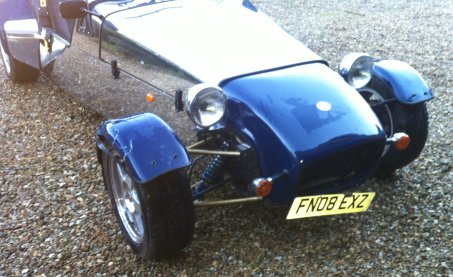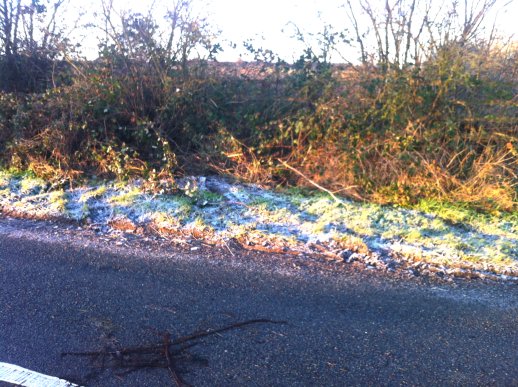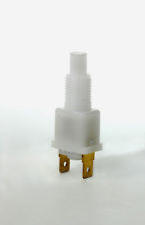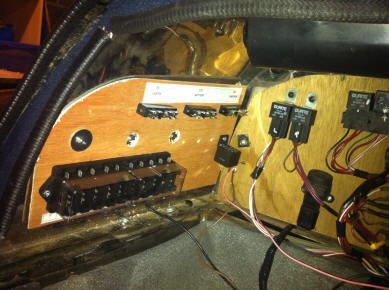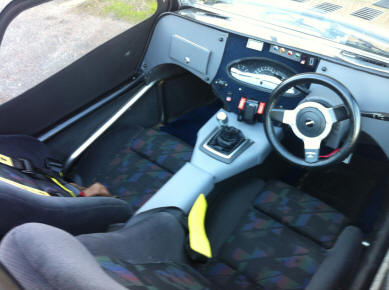Just had my first crash :-)
On the way back from the filling station, there is a sharp corner and I have got into the habit of going round fairly briskly in
3rd gear and hitting the throttle half way
round for a bit of a slide (great fun). I was behind someone today so was actually in 2nd
gear and the road must have been a bit damp as I did the same trick,
the back end departed, car went sideways and I exited stage right into
the hedge. Luckily I was at low speed and there was no ditch so
although the front of the car was well buried in the undergrowth, I was
able to back out under my own steam. Got the radiator intake full of
vegetation but the only damage is to the number plate, the offside wing,
and my pride I suppose it was
inevitable this would happen eventually, so I was lucky that at least
the damage is minimal. I will treat her with a bit more respect now and
perhaps start acting my age. :-)
Here is what she looks like (although I did give her a good clean before the taking the photo)
So I just need to buy a new number plate and learn how to 'patch' repair GRP. Another 'entry' I shall
add to my skill set. I'm guessing it is just like repairing fibreglass.
And here is the scene a couple of days later. The hedge was so overgrown that no-one would ever know if it wasn't for the tyre tracks :-)
SuperSpec

Thursday, 26 December 2013
Friday, 20 December 2013
Exhaust Pipe Repaired
After a bit of driving I got the
impression the exhaust was blowing a bit. There were various symptoms:
a. I could hear a noise coming from the side of the car.
b. There was a bit of a 'burble' on the overrun.
c. The car was not happy when running in 1st gear after being left for an hour or so. I suspected that was down to the lamda sensor not reading correctly and that would be explained by a leak just in front of it.
d. The car had been marginal on the emissions test, again pointing to the lamda sensor not getting the right readings.
Once I removed the heat shield it was confirmed as there was a distinct sooty deposit on the bodywork.
The lamda sensor is just behind the leak.
So I removed the clamps and the outer tube and it was apparent that there was no corrosion, it was simply that the sealant used by the previous owner had all disappeared and it was simply leaking through the joint.
That was not surprising as the exhaust had been fitted 5 years ago and not touched since. Also the exhaust manifold is 'lagged' inside the engine bay to cut down the heat, but that does mean that the joint would have been running hotter than normal.
I decided to repair it using a mix of new ideas and the 'old-school' approach. It meant it is rather 'over-engineered' but that is no bad thing.
So first a liberal dose of Gun Gum (that is what we used to use and is still the best around), followed by a thin aluminimum foil protector.
Followed by an exhaust bandage that solidifies with the heat of the exhaust.
And finally a clamped cover to protect and support the whole thing using an empty Heinz Baked Beans tin (honest!). That is what we used to use 40 years ago and it is still perfectly good.
Result: A quieter exhaust and engine running smoother. Hopefully it will have improved the emissions, I will find out at the next MOT.
a. I could hear a noise coming from the side of the car.
b. There was a bit of a 'burble' on the overrun.
c. The car was not happy when running in 1st gear after being left for an hour or so. I suspected that was down to the lamda sensor not reading correctly and that would be explained by a leak just in front of it.
d. The car had been marginal on the emissions test, again pointing to the lamda sensor not getting the right readings.
Once I removed the heat shield it was confirmed as there was a distinct sooty deposit on the bodywork.
The lamda sensor is just behind the leak.
So I removed the clamps and the outer tube and it was apparent that there was no corrosion, it was simply that the sealant used by the previous owner had all disappeared and it was simply leaking through the joint.
I decided to repair it using a mix of new ideas and the 'old-school' approach. It meant it is rather 'over-engineered' but that is no bad thing.
So first a liberal dose of Gun Gum (that is what we used to use and is still the best around), followed by a thin aluminimum foil protector.
Followed by an exhaust bandage that solidifies with the heat of the exhaust.
And finally a clamped cover to protect and support the whole thing using an empty Heinz Baked Beans tin (honest!). That is what we used to use 40 years ago and it is still perfectly good.
Result: A quieter exhaust and engine running smoother. Hopefully it will have improved the emissions, I will find out at the next MOT.
Monday, 16 December 2013
Handbrake Warning
I soon found that I kept forgetting to release the handbrake
before moving.
And the design of the Superspec means that it is very difficult to release it when you are already strapped in (a combination of the handbrake being in the passenger footwell and the fact you are strapped in with a 4-point harness).
So I determined I needed to fit a warning light.
That needed a switch and after trawling E-Bay I came up with this one.
The first idea was to just pop-rivet it to the floor underneath the car, in front of the handbrake. But I realised I need to be able to adjust it after it was fitted to ensure it matched the position of the brake. And after breaking 3 drill bits in fairly short order I decided to rethink the design. So I mounted it on a separate piece of stainless steel with adjustable slots that I could mount on existing bolts in the floor.
The idea was good but unfortunately I found that the movement of the mechanism under the car was not sufficient to overcome resistance in the spring so it was impossible to adjust it correctly. It looks as though I will have to do something inside the passenger compartment, where the movement of the lever is greater.
So after quite a lot of work I am back to square one. But that is half the fun of course.
And the design of the Superspec means that it is very difficult to release it when you are already strapped in (a combination of the handbrake being in the passenger footwell and the fact you are strapped in with a 4-point harness).
So I determined I needed to fit a warning light.
That needed a switch and after trawling E-Bay I came up with this one.
The first idea was to just pop-rivet it to the floor underneath the car, in front of the handbrake. But I realised I need to be able to adjust it after it was fitted to ensure it matched the position of the brake. And after breaking 3 drill bits in fairly short order I decided to rethink the design. So I mounted it on a separate piece of stainless steel with adjustable slots that I could mount on existing bolts in the floor.
The idea was good but unfortunately I found that the movement of the mechanism under the car was not sufficient to overcome resistance in the spring so it was impossible to adjust it correctly. It looks as though I will have to do something inside the passenger compartment, where the movement of the lever is greater.
So after quite a lot of work I am back to square one. But that is half the fun of course.
Monday, 9 December 2013
Brake Lights
At some point the brake lights failed. No idea when as it is not something you see as a driver. After some investigation it appeared the switch was the cause. When I took it apart it was burnt and corroded inside. Apparently not unusual.
This is the location of the switch, just in front of the brake pedal.
Pressing the brake pedal closes the switch and turns the lights on.
I couldn't find a replacement but did find one from a Mini on E-Bay at 99p.
But fitting it on showed a problem. The brake lights were permanently on. Turns out that whereas the original was a 'push-to-make' switch, this one was a 'push-to-break' switch.
But rather than try and find another replacement I simply fabricated a new mounting bracket from a stainless steel offcut and mounted it behind the brake pedal instead of the front, adjusting it so that it was pushed close when the brake pedal was in the normal position.
Very pleased with myself for lateral thinking !!
Status: Complete
This is the location of the switch, just in front of the brake pedal.
Pressing the brake pedal closes the switch and turns the lights on.
I couldn't find a replacement but did find one from a Mini on E-Bay at 99p.
But fitting it on showed a problem. The brake lights were permanently on. Turns out that whereas the original was a 'push-to-make' switch, this one was a 'push-to-break' switch.
But rather than try and find another replacement I simply fabricated a new mounting bracket from a stainless steel offcut and mounted it behind the brake pedal instead of the front, adjusting it so that it was pushed close when the brake pedal was in the normal position.
Very pleased with myself for lateral thinking !!
Status: Complete
Sunday, 1 December 2013
Auxiliary Electrical Panel
I decided that trying to fix electrical problems when things go wrong would be quite difficult and it would make sense just to 'hot-wire' them. So I decided to add an extra wiring panel to the side of the car next to the existing panel.
Across the top were 3 'busbars' that I could just plug accessories into (such as the iPhone charger). They were:
a. Earth
b. 12V direct from Battery
c. 12V from Ignition Switch
I also added a heavy duty fuse box and mountings for 4 Relays.
Here it is beginning to be used. The 12V Charger socket is wired in through a fuse, the bus-bars are now wired in, black for neutral, Blue for 12V Battery and Red for 12V Ignition switched.
A few services, mainly the extra warning lights, are wired in and a voltmeter and multi-connector have been added.
Status: Ongoing but will gradually fill it up.
Across the top were 3 'busbars' that I could just plug accessories into (such as the iPhone charger). They were:
a. Earth
b. 12V direct from Battery
c. 12V from Ignition Switch
I also added a heavy duty fuse box and mountings for 4 Relays.
Here it is beginning to be used. The 12V Charger socket is wired in through a fuse, the bus-bars are now wired in, black for neutral, Blue for 12V Battery and Red for 12V Ignition switched.
A few services, mainly the extra warning lights, are wired in and a voltmeter and multi-connector have been added.
Status: Ongoing but will gradually fill it up.
Saturday, 30 November 2013
To SORN or not to SORN
Now that the summer is finished and the weather is getting poor the big decision for all kit car owners comes around. Should you take the car off the road and do all those jobs that have been stacking up over the summer. Or do you brave the cold weather and continue to drive the car over the winter.
My decision: Keep her running and just wrap up warmly.
My decision: Keep her running and just wrap up warmly.
Wednesday, 27 November 2013
Dashboard Project - Phase Four
The next stage was covering the gear lever housing and transmission tunnel in vinyl to match, and I took the opportunity to fit a nice chrome surrounded gear lever mounting of a Ford Fiesta.
For my birthday I treated myself to a new set of warning lights that actually have the correct symbols displayed. So far they are: Cooling fan, Alternator, Oil Pressure and Indicators. I have also got ones for Headlight Full Beam and Handbrake Warning, which are still to be fitted.
Status: - Getting there slowly, just centre console left.
Status: - Getting there slowly, just centre console left.
Saturday, 23 November 2013
Battery Isolation Switch
I got sick and tired of disconnecting/reconnecting the battery while I was testing the electrics so I fitted a Battery isolation switch.
For those that don't know, if you remove that red key the car is then completely dead electrically and will not start. It's official purpose is to make it more difficult to steal so that might come in useful if I ever have to leave it somewhere.
Although you can buy those keys for £1.50 off E-Bay so I guess a professional thief would carry one around with him,
But it would deter the casual thief and stop those people who think it is clever to reach in and turn on the hazard warning lights to drain the battery.
Status: Complete
For those that don't know, if you remove that red key the car is then completely dead electrically and will not start. It's official purpose is to make it more difficult to steal so that might come in useful if I ever have to leave it somewhere.
Although you can buy those keys for £1.50 off E-Bay so I guess a professional thief would carry one around with him,
But it would deter the casual thief and stop those people who think it is clever to reach in and turn on the hazard warning lights to drain the battery.
Status: Complete
Saturday, 16 November 2013
The Starting Problem
There are a few thoughts on why the engine struggles to crank when you try and start a hot engine:
1. The engine itself ‘tightens’ up when it is warm, making it difficult to turn over.
2. Advice on the forum is that the absence of a decent earth strap from engine to chassis can cause a voltage drop.
3. If the ignition advance is too much it would make it difficult to turn over.
There is nothing I can about (1), and (3) is controlled by the ECU, so all I can do is fit a proper earth strap and hope it helps.
Here it is:
I also decided to add a voltmeter into the circuit so I could see if the battery was struggling. I didn't want it to be a permanent distraction so mounted it on the auxiliary electrical panel where it can easily be viewed when troubleshooting.
As you can see, at 12.5V it is quite healthy. When the ignition is switched on it drops to 12.3V, which is fair. If you turn on a high-power system like the demisters or the headlights then it drops to 11.8V, not unexpected. Once the engine is running it shows 14.1V which means the alternator is charging it well.
The only slight concern is that while cranking it initially drops to 9V before recovering to 9.8V. That is marginal. Something to keep an eye on.
Update: March 2014 - Now had a chance to try a hot start and everything was fine. See "Sunday Run with Hot Start"
Status: Complete
1. The engine itself ‘tightens’ up when it is warm, making it difficult to turn over.
2. Advice on the forum is that the absence of a decent earth strap from engine to chassis can cause a voltage drop.
3. If the ignition advance is too much it would make it difficult to turn over.
There is nothing I can about (1), and (3) is controlled by the ECU, so all I can do is fit a proper earth strap and hope it helps.
Here it is:
I also decided to add a voltmeter into the circuit so I could see if the battery was struggling. I didn't want it to be a permanent distraction so mounted it on the auxiliary electrical panel where it can easily be viewed when troubleshooting.
As you can see, at 12.5V it is quite healthy. When the ignition is switched on it drops to 12.3V, which is fair. If you turn on a high-power system like the demisters or the headlights then it drops to 11.8V, not unexpected. Once the engine is running it shows 14.1V which means the alternator is charging it well.
The only slight concern is that while cranking it initially drops to 9V before recovering to 9.8V. That is marginal. Something to keep an eye on.
Update: March 2014 - Now had a chance to try a hot start and everything was fine. See "Sunday Run with Hot Start"
Status: Complete
Tuesday, 12 November 2013
The 'Electrics' Project - Services
The next stage was a list of all the electrical
‘services’, annotated as to whether they used a ‘direct’ 12V supply or an
ignition switched 12V, whether they ought to use a Relay (and if so which one),
and which fuse they used.
(Red is unknown)
Instrument Panel Wiring
The 2 White wires are interchangeable

Light Switch gets Direct Power from Fuse 1.
Pins 86 get fed an ignition switched earth feed (Apparently not, seems to be permanent earth?)
1. Where is the relay for the Lamda Sensor Heater ?
(Red is unknown)
Service
|
12V
|
Colour
|
Relay
|
Fuse
|
Demisters
|
Ignition
|
Yes – Relay 1
|
3
|
|
Fog Lights
|
Direct
|
Blue/Yellow
|
Yes – Relay 2
|
4
|
Horn
|
Direct
|
Purple/Black
|
Yes – Relay 3
|
1
|
Headlights (Main)
|
Direct
|
Blue/Red
|
Apparently none
|
1
|
Headlights (Dipped)
|
Direct
|
Blue/White
|
Apparently none |
1
|
Cooling Fan
|
Direct
|
???
|
Yes - Relay at Front
|
11 |
ECU
|
Ignition
|
Green/Pink
|
Yes - Not found
|
?
|
Lamda Sensor
|
Ignition
|
Green
|
Yes - Relay 4
|
?
|
Fuel Pump
|
Ignition
|
White
|
Yes - Relay 5
|
?
|
Indicators
|
Ignition
|
Green/White
|
Yes – Flasher Relay
|
?
|
Hazards
|
Direct
|
Green/White
|
Yes – Flasher Relay
|
?
|
Sidelights
|
Direct
|
Red
|
No
|
4
|
Number Plate Light
|
Direct
|
Red
|
No
|
4
|
Reversing Lights
|
Direct
|
???
|
No
|
10
|
Brake Lights
|
Ignition
|
Green/Purple
|
No
|
4
|
Cluster Illumination
|
Ignition
|
Red
|
No
|
4
|
Instruments
|
Ignition
|
Green
|
No
|
2
|
Warning Lights
|
Ignition
|
Green
|
No
|
2
|
Wipers
|
Ignition
|
Blue/Yellow
|
No
|
?
|
Washers
|
Ignition
|
Green/Black
|
No
|
?
|
Just for completeness I figured out the Instrument Panel
wiring: (Blue means Not used, Red means don’t know)
Pin
|
Colour
|
Usage
|
White Plug
|
||
12
|
Red
|
+12V for Panel illumination
|
11
|
Blue/White
|
Headlight Full Beam Warning
|
10
|
Black
|
Earth for Headlamp Warning and Panel Illumination
|
9
|
Not Used
|
(ABS warning light)
|
8
|
Black/Yellow
|
Handbrake/Brake
Fluid Level Warning Light
|
7
|
White/Green
|
‘S’ Connector on Temperature Gauge (Sender)
|
6
|
White
|
‘S’ Connector on Fuel Gauge (Sender)
|
5
|
Black
|
‘E’ (Earth) (Earth) for Fuel and Temperature Gauge
|
4
|
Not Used
|
(Diesel GlowPlug)
|
3
|
Not Used
|
(Washer Fluid Level)
|
2
|
Not Used
|
(Low Fuel)
|
1
|
Green
|
12V for lamps and ‘B+’ on Fuel & Temperature
|
Blue
Plug
|
||
1
|
Black
|
Earth for Indicator Lights
|
2
|
????*
|
Indicator Lights
|
3
|
Not Used
|
(Windows ??)
|
4
|
Not Used
|
(?????)
|
5
|
Not Used
|
(Seat Belt)
|
6
|
?????*
|
From Negative Side of Coil
(not connected on board ?)**
|
7
|
Brown/Yellow
|
Alternator Warning Light
|
8
|
?????*
|
‘E’ on Tachometer (from +ve side of coil)
|
9
|
?????*
|
‘S’ on Tachometer
|
10
|
White/Brown
|
Oil Pressure Warning
|
11
|
Not Used
|
(Rear Screen Heater)
|
12
|
Green
|
‘B’ on Tacho (12V ignition switched)
|
* I will be able to
complete the colour column when I remove the centre dashboard.
** The
wiring diagram says to connect to coil but on PCB on back of cluster it doesn’t
appear to be connected to anything.
LAMDA
SENSOR
Not something I have seen before so needed to figure out
the wiring. Seems it is:
Sensor
|
Engine
Plug
|
Function
|
White*
|
Black
(Earth)
|
Heater
|
White*
|
Brown/Blue (Power)
|
Heater
|
Grey
|
Green
|
Signal
|
Black
|
Grey
|
Earth
|
The 2 White wires are interchangeable
ECU
The Electronic Control Unit is a ‘black box’, but I did
find a breakdown of the connections:
Pin
|
Colour
|
Function or Termination
|
Comments
|
1
|
White/Yellow
|
Coil -ve
|
Not Used
|
2
|
Pink/Blue
|
Stepper Motor Phase 2
|
|
3
|
Orange/Grey
|
Stepper Motor Phase 1
|
|
4
|
White/Pink
|
Feed from main ECU relay
|
-ve side of Switching Circuit
|
5
|
Not Used
|
Air Con Control
|
|
6
|
Not Used
|
Cooling Fan Relay
|
|
7
|
Grey
|
Lambda sensor +
|
Revised wiring extension
|
8
|
Yellow/Green
|
Throttle Sensor Supply
|
|
9
|
Yellow/Purple
|
Throttle Sensor Input
|
|
10
|
Pink
|
Diagnostics Output
|
|
11
|
Green/Pink
|
Ignition Sensing
|
|
12
|
Not Used
|
Electronic Tacho Output
|
|
13
|
Black/White
|
Immobiliser Control
|
Disabled
|
14
|
Not Used
|
??
|
|
15
|
Not Used
|
Air Con Control
|
|
16
|
Green/Black
|
Air Temp Sensor Input
|
|
17
|
Yellow
|
Engine Knock Sensor
|
|
18
|
Light Green
|
Lambda sensor -
|
|
19
|
Not Used
|
Air Con Control
|
|
20
|
Black/Purple
|
Fuel Cut off Relay Control.
|
-ve side of Switching Circuit
|
21
|
Yellow/Orange
|
Boost Purge Valve
|
|
22
|
Orange/Green
|
Stepper Motor Phase 3
|
|
23
|
Yellow/Green
|
Injector 1-4
|
|
24
|
Yellow/Blue
|
Injector 2-3
|
|
25
|
White/Black
|
Coil +
|
Actually to Coil -ve
|
26
|
Not Used
|
Cruise Control
|
|
27
|
Orange/Blue
|
Stepper Motor Phase 4
|
|
28
|
Brown/Pink
|
+12V Power
|
+ve Power circuit from Relay
|
29
|
Black
|
ECU Earth
|
|
30
|
Pink/Black
|
Engine Sensors Earth
|
|
31
|
Blue
|
Crankshaft Sensor +
|
|
32
|
White
|
Crankshaft Sensor -
|
|
33
|
Pink/Green
|
Coolant Sensor Input
|
|
34
|
Grey/Pink
|
Fuel Rail Sensor Input
|
|
35
|
Not Used
|
Air Con Control
|
|
36
|
Black/Green
|
Lambda Sensor
|
-ve side of Switching Circuit
|
LIGHTING
CIRCUIT

Pin 30 on both relays get a permanent +12 V Power Supply
from Fuse 1
Pin 87 on the relays goes to Main Beam (Blue/White) and
Dipped Beam (Blue/Red)
Light Switch gets Direct Power from Fuse 1.
Position 1 sends power to
sidelights through (Red/Grey)
Position 2 sends power to High/Dip
Switch which feeds Pin 85 of appropriate relay
Pins 86 get fed an ignition switched earth feed (Apparently not, seems to be permanent earth?)
Status: Lots to do, I still have the following outstanding questions
1. Where is the relay for the Lamda Sensor Heater ?
2. What are Fuses 5-9 for ?
3. Where are the fuses for the indicators and wipers/washers ?
3. Where are the fuses for the indicators and wipers/washers ?
Subscribe to:
Comments (Atom)
